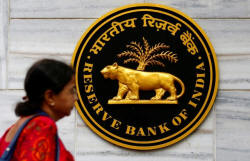For India's banks, the worst of their bad-loan woes may
be yet to come
 Send a link to a friend
Send a link to a friend
 [February 14, 2018]
By Devidutta Tripathy [February 14, 2018]
By Devidutta Tripathy
MUMBAI (Reuters) - Just when many Indian
banks thought the worst of their bad debt woes were behind them, new
central bank rules are stoking fears that the worst of the soured-loans
buildup is yet to come.
The central bank surprised the financial sector this week by halting all
of its existing loan-restructuring mechanisms with immediate effect, and
rolling out new rules that will push more debt defaulters into
bankruptcy courts.
To force its point home, the Reserve Bank of India (RBI) set strict
timelines for lenders to take action against defaulters, threatening
penalties if banks failed to act in a timely manner.
Soured loans, which include non-performing, restructured or rolled-over
loans, reached a record high of 9.5 trillion rupees ($148 billion) in
the middle of last year before dipping slightly and prompting some
relief among bankers that the worst was over. State-run lenders account
for the bulk of these loans.

India's bad loans have nearly doubled in the past four years following
an economic slow down and years of profligate lending - the combination
has choked new lending and dragged on the economy.
Analysts say the actual level of bad loans is higher than the official
figures suggest, pointing to central bank audits of banks, including
State Bank of India <SBI.NS>, that showed non-performing loans were
higher than reported for the financial year ended March 2017. Banks have
also been blamed for perpetually renewing loans on soured assets.
Most of the loan-restructuring schemes that the central bank is
withdrawing have seen little success. Analysts say banks will soon have
to declare the loans in those schemes as non-performing loans, which
will trigger the timeline for banks to take debtors to court.
That means the banking sector will have to recognize the new status of
the loans and make provisions for them, said Rajkiran Rai, chief
executive at state-run Union Bank of India <UNBK.NS>.
"When you look at the short term, yes, we will have issues with the
existing accounts," Rai said.
Longer term, the RBI's measure will benefit banks, he said.
Indeed, the new rules would bring discipline to the banking sector,
although provisioning costs will shoot up as more borrowers are taken to
court, said R. Subramaniakumar, chief executive at Indian Overseas Bank
<IOBK.NS>, a state-run lender with the second-highest bad loan ratio
among all banks.

[to top of second column] |

A woman walks past the
Reserve Bank of India (RBI) head office in Mumbai, India, December
6, 2017. REUTERS/Shailesh Andrade/File photo

"Of course it's going to put pressure on bank's balance sheets," he said, adding
capital injections announced by the government will help cushion the impact.
The RBI's decision to force more struggling borrowers into bankruptcy
proceedings was its latest move to try to clean up India's bad loans mess.
Last year, it ordered about 40 of the country's largest debt defaulters into
bankruptcy courts, demanding creditors put aside at least 50 percent of loan
amounts in provisioning.
Under the new process, the RBI requires banks to figure out plans to resolve
debts of defaulters with 20 billion rupees ($311 million) or more in outstanding
debt by Sept. 1, or take them to bankruptcy court.
Since 50 percent provisioning will be required for these bankruptcy cases as
well, the total funds that banks will have to set aside will shoot up,
pressuring profits, analysts said.
Moody's Indian affiliate ICRA estimates the criteria would net 50 defaulting
companies with combined outstanding debt of 2.46 trillion rupees ($38 billion),
so banks' credit provisions will spike.
India Ratings and Research, the local affiliate of Fitch, said banks'
non-performing loans and provisions will shoot up in coming months, said analyst
Udit Kariwala.

Rajeev Kumar, the top government bureaucrat overseeing the banking sector, said
the new rules will impact 2-3 percent of banks' loan books, while provisions
could rise a "little", financial news service NewsRise reported.
Bank shares slid on Wednesday, with the sector index <.NSEBANK> falling 1.4
percent compared with a 0.4 percent fall in the broader market.
Indian banks' stressed-loan ratio - http://tmsnrt.rs/2DwCB1A
India's bank recapitalisation plan - http://tmsnrt.rs/2DwYLkk
(Reporting by Devidutta Tripathy; Editing by Neil Fullick)
[© 2018 Thomson Reuters. All rights
reserved.] Copyright 2018 Reuters. All rights reserved. This material may not be published,
broadcast, rewritten or redistributed.
Thompson Reuters is solely responsible for this content. |